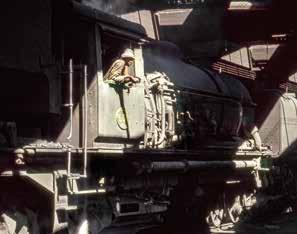




The mail is scheduled to arrive at Victoria Falls before sunrise in winter, so it can only be photographed north of TJ when running late. We were very fortunate to find it running nearly two and a half hours late one morning, and it is seen at Zanguja behind 15th 372 after the 25km climb from Deka River. This is one of the best photographic locations on this section of line, especially on a clear morning such as this when colliery smoke is not being blown north and you can see bush country stretching many miles into the distance. However, the location is some way from the nearest road access and care is needed as lions have been seen in this area.


joy of
and

associated with the unceasing tasks of operating live steam is well in evidence in these views of 15th 372 and
and maintain, there was a need for a very large staff contingent, managed with a rod of iron by the
fitting
were being employed on contract at both Bulawayo and Thomson junction (TJ). Only

Yes, the smoke is just about right.”
The ageing signal gantries, disused telegraph lines and broken glass are all a sign of the times.14A 519 looks the part while barrelling out of Bulawayo station through Westgate.Sadly, the leaking steam, highlighted by the backlight and the vegetation, tells another story. Within one hour, the front water tender had developed a serious leak halfway up the tank, a leak which chewing gum failed to cure. That was the end of 519’s journey in lovely early morning light. Our destination, Cement, 21 kilometres out from Bulawayo (walking time about 4 hours) was reached many hours later. As for the hole in the tender, it received a metal patch some days later, Africa style! I am sure you know what I mean!











Illuminated by the last rays of sunlight, 611 makes its final shunting movement of the day, marshalling the loaded coal wagons in preparation for their run down to Thomson Junction the following day.
DEATH CAN BE CRUEL, EVEN FOR FAITHFUL SERVANTS

Does the mythical elephant’s graveyard really exist? Is there a fabled, secret place where the great beasts wandered off alone, to die. In railway terms it does, and can be found in Bulawayo, in the overgrown sidings behind the steam loco depot.
The thorns are the only protection for this endangered species.






Like

TIME TO CALL IT A DAY
NRZ 15A 414 makes its final shunting manoeuvre before moving to the depot for the very last time. A servicing crew with their train from NRZ Bulawayo were waiting to collect the loco and return it to there the following day.
The rumour mongers from the service team were of the opinion that a diesel would be used in future.
From what has been learned since that evening in June 2018, this was indeed the last working day on which steam was used by Hwange Colliery and the very last use of a steam loco in revenue earning service anywhere in the Dark Continent. How appropriate that this duty was performed by a Garratt.
When I wrote that ‘The Reign of the Mikado’was the final book in the series, like the rest of the world, I did not know what was coming. This “life pause” resulted in a further 176 pages and a garden that is now under control… Fortunately, my office has not suffered the same fate.
Contents of the book
ABRIEF HISTORY OF THE BEYER-GARRATT LOCOMOTIVE
Bob Illingworth
GARRATTS IN RHODESIA
Bob Illingworth
GARRATT OPERATIONS IN POST-INDEPENDENCE ZIMBABWE
Dick Manton ‘Awindow of opportunity’including photography GARRATTS IN RETREAT POST 1993 OPERATIONSAT HWANGE COLLIERY
DEATH CAN BE CRUEL, EVEN FOR FAITHFUL SERVANTS
Dave Hill ‘Endangered Species’including post processing of the images
Details on this book.
Hardback, landscape format, page size 300 x 250mm. Printed on Regency Satin finish paper and hand sewn. 176 pages with 220 captioned images, maps and diagrams.
